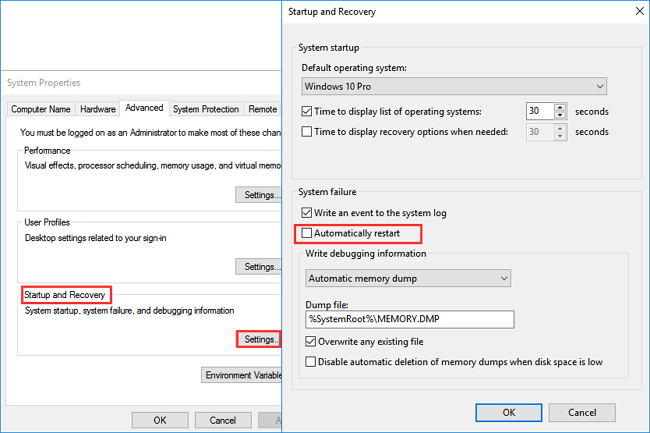
 Spot what says “ Automatically restart” below the “ System Failure” section and clear the checkbox beside it. Click “ Settings” below the third category (Setup and Recovery). In the new window, jump to the “ Advanced” tab. Select “ Properties” from the drop-down list to go to “ Advanced System settings.”. Right-click on “ This PC” (or whatever you named it). Instead, your PC communicates the issue through an error message on your display. If your problem has something to do with your programs, you won’t get an unexpected restart after disabling this function. Microsoft has an Automatic Restart feature that, when enabled, lets Windows automatically reboot itself whenever it runs into a serious software issue. Click OK and wait until the Windows loads normally. After switching to the Boot tab, spot the “ Safe Mode” and unmark it. Once the Run dialogue box opens, type “ msconfig” (without quotation marks) and hit Enter. Use your keyboard to press R + Windows keys simultaneously. Therefore, it’s wise to skip the next eight solutions and start from “ Check Your CPU Temperatures.”īefore trying to figure out the root cause, you need to go back to its normal mode of operation: If it continues to behave the same, chances are you’re facing a hardware or Windows problem.
Spot what says “ Automatically restart” below the “ System Failure” section and clear the checkbox beside it. Click “ Settings” below the third category (Setup and Recovery). In the new window, jump to the “ Advanced” tab. Select “ Properties” from the drop-down list to go to “ Advanced System settings.”. Right-click on “ This PC” (or whatever you named it). Instead, your PC communicates the issue through an error message on your display. If your problem has something to do with your programs, you won’t get an unexpected restart after disabling this function. Microsoft has an Automatic Restart feature that, when enabled, lets Windows automatically reboot itself whenever it runs into a serious software issue. Click OK and wait until the Windows loads normally. After switching to the Boot tab, spot the “ Safe Mode” and unmark it. Once the Run dialogue box opens, type “ msconfig” (without quotation marks) and hit Enter. Use your keyboard to press R + Windows keys simultaneously. Therefore, it’s wise to skip the next eight solutions and start from “ Check Your CPU Temperatures.”īefore trying to figure out the root cause, you need to go back to its normal mode of operation: If it continues to behave the same, chances are you’re facing a hardware or Windows problem. 
If it doesn’t restart unexpectedly, you should find the source of the problem in the installed drivers, apps, viruses, etc. Let your PC operate in this mode for an hour or so.
Hit the Restart button at the bottom right. A list of reboot options will appear press F4 on your keyboard to choose the “ Safe Mode.”. Select “ Troubleshoot,” “ Advanced Options,” and then “ Startup Settings” sequentially. A new blue screen will appear and prompt you to choose an option. Press “Restart now” in the “ Advanced startup” segment. Scroll down to “ Update and Security” and select “ Recovery” from the left panel. Then, press the gear symbol in the left side ribbon to open your Windows Settings. Go to the Start menu at the bottom left of the screen. Here’s how you can run your PC in Safe Mode: This way, you will know if the difficulty is system-critical or something external. 
In this mode, all the third-party tools, additional drivers, settings, and potentially, malware will stop operating. Safe Mode is a diagnostic feature that disables the non-essential features, apps, and services. Read on to discover a few possible causes and learn how you can fix them.Ĭomputer Randomly Restarts-No Blue Screen (Causes, Fixes) You want to know why your computer is caught in a reboot cycle and how you can fix it. Most importantly, it’s probably a sign of a more severe problem that can cause further disasters if left unchecked. You’ll lose your unsaved projects, muddle up your tasks, and get discouraged to continue working.

Random restarts are frustrating on their own, even if they occur without showing a blue screen of death (BSOD).








 0 kommentar(er)
0 kommentar(er)
